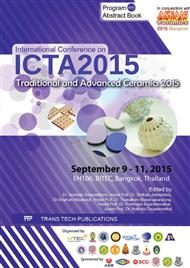p.194
p.200
p.206
p.212
p.218
p.224
p.230
p.236
p.240
Comparison of Milling Techniques to Figure of Merit of 0.98PZT-0.02BYF Piezoelectric Ceramic Energy Harvester
Abstract:
Nowadays, the concept of harvesting energy from the environment, for example, thermal, wind, sun, vibration and human activities is much of interest. PZT is one of the materials which show an ability to harness vibration energy and then change to electrical energy. Therefore, the PZT (Pb(Zr0.53Ti0.47)O3) doped with 0.02 mol% BYF (Bi(Y0.7Fe0.3)O3) piezoelectric ceramics has been studied to improve the figure of merit (d33*g33). The PZT and BYF powder systems were prepared by solid state reaction with calcination temperature of 800 and 850 °C for 2 h, respectively. XRD results showed that both powders exhibited pure perovskite phase for PZT and single phase of BYF without pyrochlore phase. Then, the two calcined powders (PZT and BYF) were mixed according to the composition of 0.02 mol% BYF doped PZT by two different milling techniques called conventional ball-milling (CBM) and high energy ball-milling (HBM) for 10 h. The result showed that average particle size obtain from HBM was 1 µm which was smaller than from CBM shown up to a few microns in bimodal mode. The PZT-BYF-HBM ceramics showed higher physical and electrical properties but lower K value. Thus promoting to higher g33 which was equal to 36.89 * 10-3(Vm/N) and FOM was 11,632*10-15(m2/N), while PZT-BYF-CBM had g33 of 26.86* 10-3(Vm/N) and FOM at 8,016*10-15(m2/N), respectively.
Info:
Periodical:
Pages:
218-223
Citation:
Online since:
May 2016
Price:
Сopyright:
© 2016 Trans Tech Publications Ltd. All Rights Reserved
Share:
Citation:


